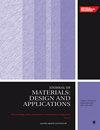Preparation, characterisation and properties of green composites from Pinus roxburghii fibre
IF 2.2
4区 材料科学
Q3 MATERIALS SCIENCE, MULTIDISCIPLINARY
Proceedings of the Institution of Mechanical Engineers, Part L: Journal of Materials: Design and Applications
Pub Date : 2024-01-03
DOI:10.1177/14644207231225068
引用次数: 0
Abstract
Pinus roxburghii needles are plentiful in the Himalayas and may be processed into a natural fibre. In this research, polylactic acid composites were made, including both untreated and treated Pinus roxburghii fibres as reinforcing materials. The Pinus roxburghii fibres were produced by subjecting the Pinus roxburghii needle to an alkali treatment with a 5% sodium hydroxide solution in water, and the Pinus roxburghii fibres were obtained by a water retting extraction method. Pinus roxburghii fibre–polylactic acid composites were made using a compression moulding process. Composites were fabricated utilizing treated and untreated Pinus roxburghii fibre with fibre loadings of 20%, 30%, and 40% by weight. Subsequently, the investigators examined the alterations in the tensile, flexural, impact, and morphological properties with sodium hydroxide treatment. As expected, alkaline treatment considerably boosted the compatibility between Pinus roxburghii fibre and polylactic acid, leading to improvements in the morphological, hardness, and mechanical characteristics of Pinus roxburghii fibre composites. In addition, when 30 wt.% of treated fibres were used, the mechanical characteristics improved.罗布麻纤维绿色复合材料的制备、表征和性能
喜马拉雅山脉盛产罗布松针叶,可将其加工成天然纤维。在这项研究中,制作了聚乳酸复合材料,其中包括未处理和处理过的罗布松纤维作为增强材料。罗布麻纤维是用 5%氢氧化钠水溶液对罗布麻针叶进行碱处理后制成的,而罗布麻纤维则是通过水甑提取法获得的。罗布麻纤维-聚乳酸复合材料采用压缩成型工艺制成。复合材料是利用处理过和未处理过的罗布麻纤维制成的,纤维含量分别为 20%、30% 和 40%(按重量计)。随后,研究人员研究了氢氧化钠处理对拉伸、弯曲、冲击和形态特性的改变。不出所料,碱性处理大大提高了罗布麻纤维与聚乳酸的相容性,从而改善了罗布麻纤维复合材料的形态、硬度和机械特性。此外,当使用 30 wt.% 经处理的纤维时,机械特性也得到了改善。
本文章由计算机程序翻译,如有差异,请以英文原文为准。
求助全文
约1分钟内获得全文
求助全文
来源期刊

CiteScore
4.70
自引率
8.30%
发文量
166
审稿时长
3 months
期刊介绍:
The Journal of Materials: Design and Applications covers the usage and design of materials for application in an engineering context. The materials covered include metals, ceramics, and composites, as well as engineering polymers.
"The Journal of Materials Design and Applications is dedicated to publishing papers of the highest quality, in a timely fashion, covering a variety of important areas in materials technology. The Journal''s publishers have a wealth of publishing expertise and ensure that authors are given exemplary service. Every attention is given to publishing the papers as quickly as possible. The Journal has an excellent international reputation, with a corresponding international Editorial Board from a large number of different materials areas and disciplines advising the Editor." Professor Bill Banks - University of Strathclyde, UK
This journal is a member of the Committee on Publication Ethics (COPE).
 求助内容:
求助内容: 应助结果提醒方式:
应助结果提醒方式:


